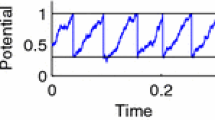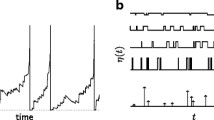Abstract
In this paper we study the well-posedness of different models of population of leaky integrate-and-fire neurons with a population density approach. The synaptic interaction between neurons is modeled by a potential jump at the reception of a spike. We study populations that are self excitatory or self inhibitory. We distinguish the cases where this interaction is instantaneous from the one where there is a repartition of conduction delays. In the case of a bounded density of delays both excitatory and inhibitory population models are shown to be well-posed. But without conduction delay the solution of the model of self excitatory neurons may blow up. We analyze the different behaviours of the model with jumps compared to its diffusion approximation.
Similar content being viewed by others
References
Brunel N, van Rossum M (2007) Lapicque’s 1907 paper: from frogs to integrate-and-fire. Biol Cybern 97: 341–349
Burkitt AN (2006) A review of the integrate-and-fire neuron model: I. homogeneous synaptic input. Biol Cybern 95: 1–19
Cáceres MJ, Carrillo JA, Perthame B (2011) Analysis of nonlinear noisy integrate and fire neuron models: blow-up and steady states. J Math Neurosci 1:7
Cai D, Tao L, Rangan AV, McLaughlin DW (2006) Kinetic theory for neuronal network dynamics. Commun Math Sci 4: 97–127
de Kamps M (2003) A simple and stable numerical solution for the population density equation. Neural Comput 15: 2129–2146
DeVille REL, Peskin CS (2008) Synchrony and asynchrony in a fully stochastic neural network. Bull Math Biol 70: 1608–1633
DeVille REL, Peskin CS, Spencer JH (2010) Dynamics of stochastic neuronal networks and the connections to random graph theory. Math Model Nat Phenom 5: 26–66
Ermentrout GB, Terman D (2010) Mathematical foundations of neuroscience. Springer, New York
Fourcaud N, Brunel N (2002) Dynamics of the firing probability of noisy integrate-and-fire neurons. Neural Comput 14: 2057–2110
Garenne A, Henry J, Tarniceriu O (2010) Analysis of synchronization in a neural population by a population density approach. Math Model Nat Phenom 15: 5–25
Gerstner W, Kistler W (2002) Spiking neuron models. Cambridge University Press, Cambridge
Izhikevich EM (2007) Dynamical systems in neuroscience. MIT Press, Cambridge
Knight B, Manim D, Sirovich L (1996) Dynamical models of interacting neuron populations in visual cortex. Robot Cybern 54: 4–8
Knight BW, Omurtag A, Sirovich L (2000) The approach of a neuron population firing rate to a new equilibrium: an exact theoretical result. Neural Comput 12: 1045–1055
Ly C, Tranchina D (2007) Critical analysis of dimension reduction by a moment closure method in a population density approach to neural network modeling. Neural Comput 19: 2032–2092
Mirollo R, Strogatz S (1990) Synchronization of pulse-coupled biological oscillators. SIAM J Appl Math 50(4): 1645–1662
Newhall KA, Kovacic G, Kramer PR, Cai D (2010) Cascade-induced synchrony in stochastically-driven neuronal networks. Phys Rev 82
Newhall KA, Kovacic G, Kramer PR, Zhou D, Rangan AV, Cai D (2010) Dynamics of current-based, poisson driven, integrate-and-fire neuronal networks. Commun Math Sci 8: 541–600
Nykamp DQ, Tranchina D (2000) A population density appraoch that facilitates large-scale modeling of neural networks : analysis and an application to orientation tuning. J Comput Neurosci 8: 19–50
Omurtag A, Knight B, Sirovich L (2000) On the simulation of large population of neurons. J Comput 8: 51–63
Ostojic S, Brunel N, Hakim V (2009) Synchronization properties of networks of electrically coupled neurons in the presence of noise and heterogeneities. J Comput Neurosci 26: 369–392
Pakdaman K, Perthame B, Salort D (2009) Dynamics of a structured neuron population. Nonlinearity 23: 23–55
Perthame B (2007) Transport equation in biology. Birkhauser, Basel
Perthame B, Tumuluri SM (2008) Nonlinear renewal equations. Math Stat 1: 1–32
Sirovich L, Omurtag A, Knight B (2000) Dynamics of neuronal populations: the equilibrium solution. J Appl Math 60: 2009–2028
Sirovich L, Omurtag A, Lubliner K (2006) Dynamics of neural populations: stability synchrony. Comput Neural Syst 17: 3–29
Author information
Authors and Affiliations
Corresponding author
Rights and permissions
About this article
Cite this article
Dumont, G., Henry, J. Population density models of integrate-and-fire neurons with jumps: well-posedness. J. Math. Biol. 67, 453–481 (2013). https://doi.org/10.1007/s00285-012-0554-5
Received:
Revised:
Published:
Issue Date:
DOI: https://doi.org/10.1007/s00285-012-0554-5
Keywords
- Population density approach
- Neural network
- Coupled population
- Integrate-and-fire
- Nonlocal nonlinear partial differential equation
- Well-posedness




